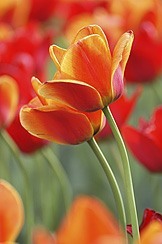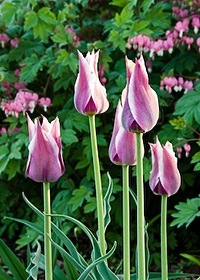Have you ever planted fabulous tulips and then found that they’re not so great after a couple of years? These flower bulbs are supposed to be perennials, so what’s going on?
Tulip bulbs are at their perennial best where growing conditions are similar to the cold winters and hot, dry summers of their mountain habitat in Turkey and other central Asian countries.
Under more moist, humid and fertile garden conditions, many hybrid varieties look spectacular the first year or two, but then their flowers get smaller or only leaves come up and the plants dwindle away.
Getting top performance

You can overcome the problem of disappearing bulbs by choosing tulip species and varieties that perennialize well (see list below).
Another tip is to plant your bulbs more deeply. The deeper you plant and the better drained your soil, the more staying power your bulbs will have.
Choose bulbs labeled as good for “naturalizing” or “perennializing.” This information is usually noted in catalogues, on garden center signs or on the pack of bulbs.
The species and their strains are a good bet. These bulbs haven’t been extensively cross-bred and are closer genetically to the bulbs found in nature.
Try the starry flowered white and gold Tulipa tarda, the cream and yellow T. turkestanica, the canary yellow T. batalinii ‘Bright Gem’ or the scarlet Tulipa praestans ‘Fusilier’.
At 6 inches tall, species are smaller than hybrid types, so grow them at the edge of flowerbeds, in front gardens and in rockeries.

Tulip ‘Ballad’ with bleeding heart
Best perennial varieties:
Single Early Varieties:‘Keizerkroon’, ‘Christmas Marvel’, ‘Couleur Cardinal’
Triumph Types: ‘Don Quichotte’, ‘Golden Melody’, ‘Kees Nelis’, ‘Merry Widow’
Darwin Hybrids: all Darwin Hybrids in red, rose, orange, yellow, and two-tone colors
Fringed Types: ‘Burgundy Lace’
Lily Flowered Varieties: ‘Aladdin’, ‘Maytime’, ‘Ballade’, ‘White Triumphator’, ‘Red Shine’
Buying, planting and care tips
Avoid bulbs that are soft, mushy or mouldy, and choose large size bulbs. Bulbs are sold by size; smaller bulbs are cheaper, but they produce smaller flowers. However, bulbs of species types are naturally smaller than hybrid tulip bulbs.
Avoid buying bulbs from stores that keep them in hot greenhouse-like conditions.
This treatment can ruin next season’s blooms. When you direct order from a bulb specialist, you will get bulbs that have been cold-stored until shipping.
More tips:
- You’ll notice that bulbs have an onion-like outer papery skin or “tunic” that can come loose or torn. This is usually not a problem and may actually promote faster rooting once the bulb is planted.
- Plant bulbs in a well-drained spot in the flower garden. Wet soil promotes fungus and disease and can even rot bulbs. Plant deeply, about eight inches deep, when measured from the base of the bulb.
- After flowering remove faded blooms, so your plants will put their energy into strengthening the bulb, not into producing seeds. Leave foliage in place to allow bulbs to “recharge” for next spring’s performance.
- Plant bulbs between groups of large perennials with strong foliage, such as peonies, Siberian iris, meadow rue, hostas and daylilies. The foliage of the perennials helps camouflage dying bulb leaves.
- If you have chosen good perennial varieties, give them a nutrient boost. Add a low nitrogen fertilizer such as well-rotted cow manure, or a special bulb fertilizer at fall planting time and then again each fall.
- If you forget to fertilize in the fall, apply a high nitrogen, fast-release fertilizer in spring when the shoots first appear.
- If you can’t resist masses of bright, colorful hybrid tulips, but just hate having yellowing leaves afterwards, consider treating them as annuals. Just dig the bulbs out after flowering to make way for summer annuals. You’ll be sure to have a terrific display each spring, and the bonus is that you can try new varieties or a whole new color scheme every year.
More Bulb Information
For spring drama, try black tulips
Daffodils – planting and care tips




